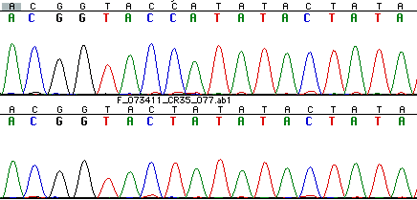
Research Projects
Interested in research?
If you are interested in working on one of these projects, set up an appointment with me to discuss your interests and fill out a general research application found in the main Biosciences office, Hagen 103.
Painted turtles population genetics
 Loading an agarose gel
Loading an agarose gel
How do painted turtles move across the landscape? How do they interact with other turtles across space and time? How big is a population of turtles? These are some of the questions we're addressing through a collaboration between myself and Dr. Donna Bruns-Stockrahm. Donna and her research students conduct research in the field by live-trapping turtles, taking a set of measurements, and letting the turtles go back into the ponds where they were found. The DNA is collected through the use of cotton mouth swabs, just like those used for human cheek cell collection. This is a minimally-invasive procedure - the turtle just needs to bite down on the swab and that's it! No blood drawn or tissues clipped. So far, the mouth swabs are working out great!
Back in the lab, we use a specific set of tools and reagents to pull the cells off the cotton swab and get the DNA out of the cells. From this DNA, we are able to produce individual genetic fingerprints for each turtle. These are the same type of genetic fingerprints that many of us are familiar with from crime scene TV shows. The reality is a little more complicated, but most of TV gets the basics close to correct. With these individual genetic fingerprints, we can learn how turtles interact with each other within and between populations.
 Sequence chromatogram
Sequence chromatogram
Many species are difficult or impossible to distinguish from related species by morphology (visible characteristics) alone. We can use select gene sequences to inform our identification. DNA batcoding is especially useful for invertebrates that have complex life cycles. We are currently using DNA sequencing of a common animal barcode gene, cytochrome oxidase 1, to identify species of invertebrate parasites in fish.
Microbial community ecology through metagenomic sequencing
 Pipetting samples
Pipetting samples
The largest range of biodiversity exists in organisms too small for us to see. Bacteria and other microorganisms live all around us, on us, and inside of us. Whole communities of microbes have been found in virtually every location on the planet, but we have much left to understand about these communitites and how microbes interact with each other and their environment. One tricky part is that most of the microbes in the environment are not able to be cultured in the lab -- some estimates are as high as 95% of species that we cannot grow and culture in the lab. So, if we can't grow these organisms in the lab, and we can't see them in their natural habitats, how do we begin to study them? One approach is to use high-throughput DNA sequencing. We can use a specific gene found in all bacteria, which codes for 16s rRNA, to identify species (or proposed species). This gene sequence is conserved within species, but different between species, which makes it useful for species identification. Using this gene as a target, we can sequence all of the DNA in an environmental sample at the same time. Environmental samples can refer to anything from soil or water in the landscape to saliva or fecal samples from a person, and many other locations. There is a lot that we can learn simply from finding out the number of species and which species occur in a location.
 Pollination!
Pollination!
We have a series of projects focused on species of bees that live in and around native tallgrass prairies in Minnesota. Over the years there has been a tremendous amount of research on honey bees, but relatively little is known about bee species native to our local landscapes. We are exploring the use of population genetics to study specific species. However, the first step is to establish or confirm species identification for several small bees. Just like the fish parasites discussed above, several small species of bee are difficult to identify by morphology alone, so we can use DNA barcoding again. Learning about native bees has many potential implications, because the ecosystem services we get from these bees may be incredibly important for pollination of both natural and agricultural systems.
 Pinned bee
Pinned bee